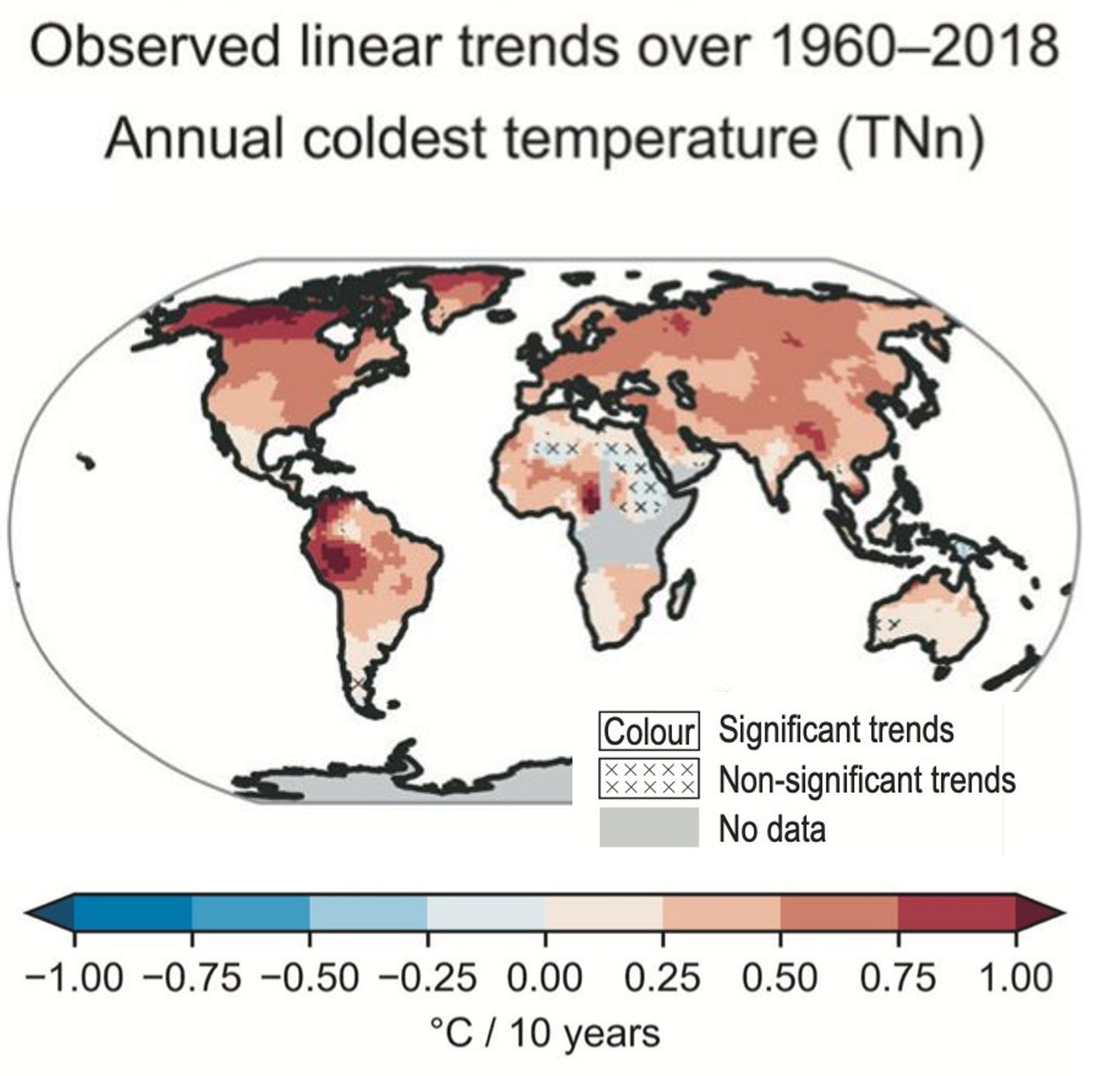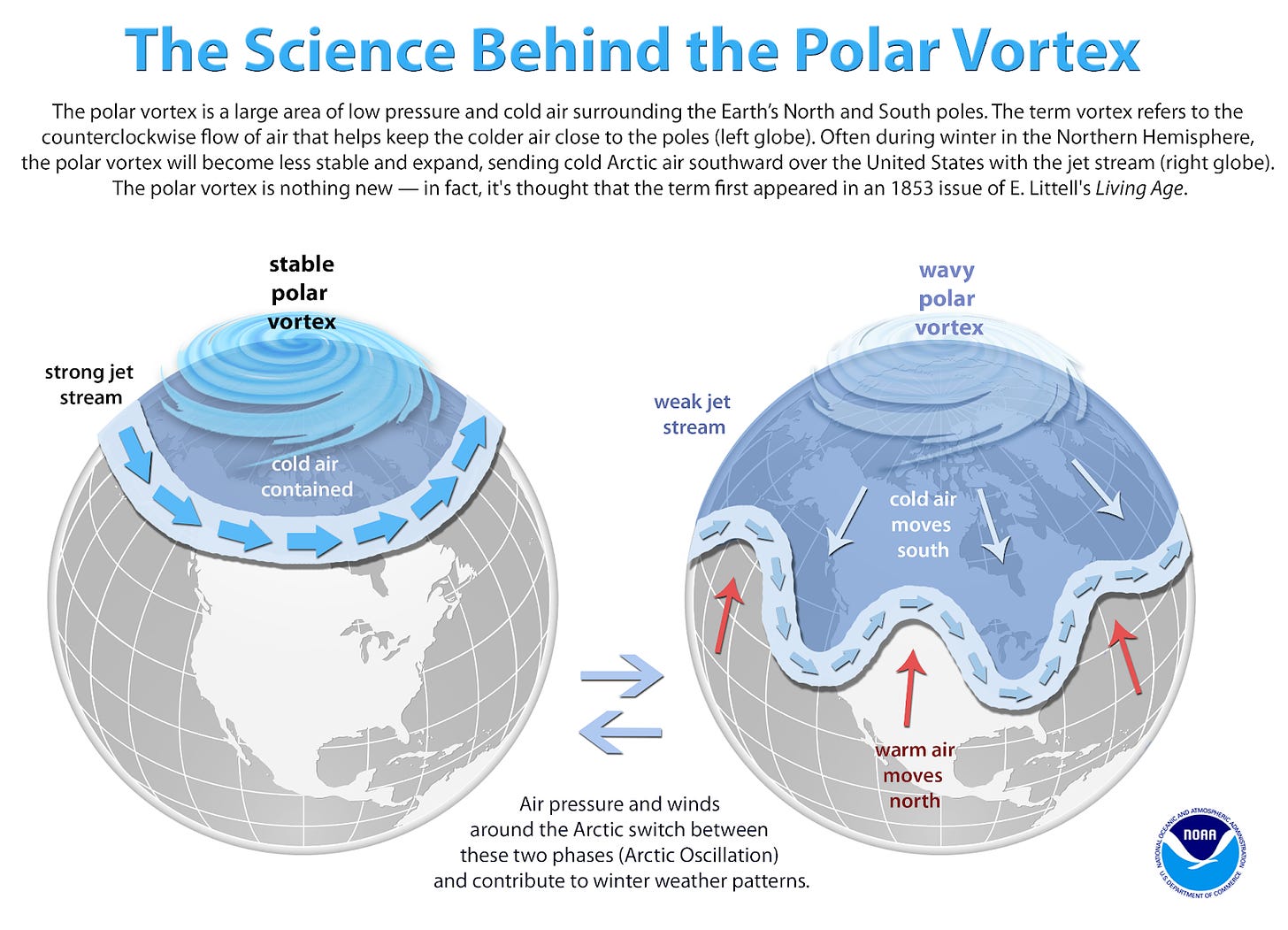With Winter Comes Extreme Cold, but Does Climate Change Make it Worse?
The science (and common sense) says no.

-
-
Share
-
Share via Twitter -
Share via Facebook -
Share via Email
-
Editor’s note: This is the fourth installment in “The Climate Report” collaborative series from The Liberal Patriot and The Breakthrough Institute looking at the science and reporting behind extreme weather events and other climate related matters.
***
Winter is right around the corner, and that inevitably means winter storms and bouts of extremely cold temperatures.
It used to be that climate change skeptics opportunistically claimed that winter weather somehow showed that the world wasn't warming. Senator James Inhofe (R-OK) famously once brought a snowball on to the Senate floor to make this dubious case. This, of course, was cherry-picking data over a particular place and time that was not representative of broader trends. These days, most people know better.
But when extreme winter weather occurs today, a major portion of the media, supported by a handful of scientists, will predictably frame the event as happening because of climate change rather than in spite of it.
If the winter of 2023-2024 is anything like other recent winters, we will see headlines like, “Climate Change Induced Cold Waves Increase the Mortality Risk of People with Heart Failure By 37%” from Forbes; “Why a Warming Climate Can Bring Bigger Snowstorms” from Scientific American; “Extreme Cold is another Curse of a Changing Climate” from Sustainability Times; or “How Climate Change and the Polar Vortex Influenced this Week’s Harsh Winter Storms,” from Inside Climate News. Such reporting often comes paired with a claim about how climate change makes all extremes—even cold temperatures—more extreme.
It’s a simple and attractive idea for many climate journalists. The problem is that it goes against common sense and the scientific consensus represented by both the Intergovernmental Panel on Climate Change’s 6th Assessment Report (IPCC AR6) and the just-released Fifth US National Climate Assessment, both of which tell us that extreme winter cold has been and is expected to continue to become milder in a warming world.
As I mentioned in a previous post on hurricanes, it can be useful to break down scientific evidence on climate change into the categories of (1) historical trends, (2) mathematical modeling, and (3) fundamental theory. Let’s take each of these categories as they apply to climate change's influence on extreme cold.
What do historical trends show about extreme cold?
There are a few ways to define and investigate trends in extreme cold. One of the most prominent is to look at how the single coldest temperature of every calendar year has changed over time. Below is the IPCC’s map of the historical trend in the annual coldest temperature at any given location. It shows almost universal warming.

Looking specifically at the eastern half of the United States, where winter weather often makes headlines, and looking at a few different measures of cold, it is clear that extreme cold has been getting less extreme and less frequent and that cold spells have been getting shorter.

We can also see similar reductions in extreme cold (the disappearing blue bars) in The National Oceanic and Atmospheric Administration’s (NOAA) Climate Extremes Index for the entirety of the US:

Given such evidence, it is not surprising that the just-released U.S. National Climate Assessment (NCA) says this about extreme cold:
Despite some recent damaging cold events, overall cold extremes are becoming less frequent and milder.
IPCC uses its most confident language (“virtually certain,” which indicates 99 to 100 percent probability) when it discusses the warming of cold extremes:
In summary, it is virtually certain that there has been…a decrease in the number of cold days and nights on the global scale since 1950. Both the coldest extremes and hottest extremes display increasing temperatures. It is very likely that these changes have also occurred at the regional scale in Europe, Australasia, Asia, and North America…Annual minimum temperatures on land have increased about three times more than global surface temperature since the 1960s, with particularly strong warming in the Arctic (high confidence). IPCC AR6 Ch 11.3.2.
What more does climate modeling tell us about changing extreme cold?
Unfortunately for climate scientists, we don't have duplicate earths to run experiments on. So in order to get estimates of what temperatures would have been like without human-caused climate change, researchers have to run physics-based climate model experiments with and without increased greenhouse gas concentrations.
These models show that the observed reduction in the frequency and intensity of cold extremes is indeed due to increased greenhouse gas concentrations. They also project continued decreases in the frequency and intensity of cold spells under all projections of future greenhouse gas emissions.

The IPCC summarizes this again with its strongest language.
In summary…it is virtually certain that further…decreases in the intensity and frequency of cold extremes, will occur throughout the 21st century and around the world…The highest increase of temperature of coldest days is projected in Arctic regions, at about three times the rate of global warming (high confidence). IPCC AR6 11.3.5
The National Climate Assessment also has a tool that allows you to examine in detail (down to the level of a U.S. county) how climate models project the frequency of extreme cold to decrease in the future.
Models and observations like these are also the basis for a tool called the Climate Shift Index, introduced this year by Climate Central. The Shift Index calculates the contribution of climate change to the risk of any temperature happening at present. The tool was embraced by climate journalists this past summer because it credibly shows a large influence of climate change on extreme heat. However, since it is based on much of the same modeling and observations as discussed above, it is going to show that whatever extreme cold we see this winter will have been made less likely due to climate change. If climate journalists are being fair, they will take these numbers at face value the same way they did when it came to extreme heat this past summer.
Fundamental theory shows why extreme cold should become less likely.
Those of us living in the middle bands of the Northern Hemisphere experience our coldest temperatures during the winter when air from the Arctic moves south over us. One of the main reasons that we are so confident that global warming should make extreme cold milder is that the air over the Arctic—the source of cold air—is warming much faster than the air over the rest of the planet in a phenomenon called “Arctic Amplification”.

In other words, when this cold air moves to the south, it is just not nearly as cold as it used to be.
Some researchers have argued that the Arctic Amplification phenomena might affect the jet stream—a river of fast-moving air in the upper atmosphere—in a way that would increase southward plunges of cold air out of the Arctic and into the mid-latitudes; the papers that make these arguments are reviewed in IPCC AR6 Box 10.1.
The idea goes like this: as you move north, temperatures get colder, but they don't usually get colder at a constant rate. Rather, there tends to be a sharp contrast between cold Arctic air to the north and mild air to the south. This sharp contrast lies underneath the jet stream. This idea will be familiar to people who regularly watch weather reports that use graphics like this:

It is not a coincidence that the jet stream occurs at the boundary between cold and warm air. The sharp contrast in temperature at the earth's surface creates large air pressure differences miles up in the atmosphere, and these pressure differences create winds. The larger the temperature difference on the ground, the faster the winds in the jet stream.
Arctic Amplification implies that cold Arctic air is warming more than the air further to the south, reducing the average contrast in temperature. This reduced temperature contrast should, in turn, reduce the wind speeds in the jet stream.
From there, a weaker jet stream might undulate more and become wavier (with a larger wave amplitude) and more meandering. This change in the character of the jet stream—which is sometimes referred to in popular vernacular as the polar vortex—is shown in the graphic below.

Since it’s the meandering of the jet stream that brings cold air south, increases in meandering could theoretically increase extreme cold at some mid-latitudes. A related hypothesis is that the length of cold spells could also increase because a wavier jet stream brings more persistent weather episodes.
However, there are problems with several aspects of these hypotheses. First, while some simple calculations suggest that a reduced temperature contrast could lead to increased weather persistence, this supposition is not supported by more complex modeling. Next, there is no generally accepted mechanism that connects the reduced temperature contrast to a wavier jet stream. Third, while some papers have claimed that there has been an observed increase in jet stream waviness, others have pointed out that this trend disappears when “waviness” is defined in different ways. Indeed, some studies even show that Arctic Amplification of warming could actually reduce jet stream waviness. Finally, many of the trends in waviness, cold, and other metrics that served as support for some initial hypotheses of how climate change could increase extreme cold have since reversed.
At the very least, we can say that any climate change-induced changes in jet stream waviness are small relative to natural variability in waviness. That’s a problem for the argument that increased waviness could actually increase cold extremes because the increase in waviness would have to be very large in order to overcome two countervailing factors. First, the entire jet stream moves north as it gets warmer, so all undulations in the jet stream will begin from a more northern latitude, making it more difficult for southward excursions of cold air to affect any given latitude. Second, because of Arctic Amplification itself, the cold air being imported south will be much warmer than it used to be. The evidence simply does not support the idea that increases in waviness could overwhelm these factors.
As the IPCC states:
“...global warming dominates changes in temperature extremes at the regional scale and it is very unlikely that dynamic responses to greenhouse-gas induced warming would alter the direction of these changes.” IPCC AR6 Ch 11.3.1
So, what’s the truth about extreme cold?
Common sense, historical observations, and physics-based climate modeling all tell us that extreme winter cold should get milder as the climate warms. Despite this logic, the idea that climate change makes cold weather even colder is just too enticing for some media outlets to resist.
Rather than having to say, “this cold happened in spite of climate change,” they get to say, “this cold happened because of climate change.” When outlets publish stories like this, they should be aware that they are jettisoning consensus climate science to perpetuate an attention-grabbing narrative that severely undermines credibility in climate reporting.
It is difficult to see how it shouldn't be considered climate misinformation.
